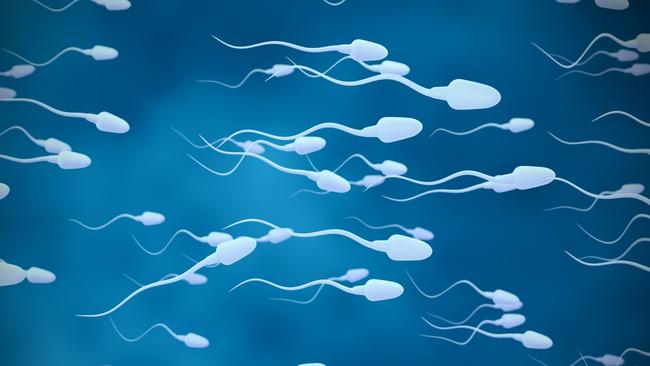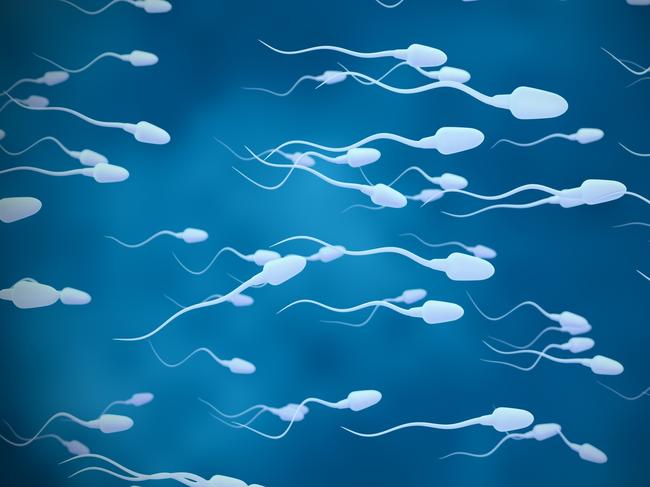Study explains why sperm rates have dropped 50 per cent
Male fertility is worryingly low. Now a study has found what is likely causing this alarming decline in active sperm.

Illness
Don't miss out on the headlines from Illness. Followed categories will be added to My News.
The decline in male fertility continues to accelerate. But the cause remained largely unknown. Now researchers believe they have an insight into what damage is being done to sperm, and by what.
The concentration of active sperm in male semen has collapsed by more than 50 per cent over the past 50 years. And that decline has only accelerated since the turn of the century.
About one in six couples experience infertility problems.
It impacts men and women equally. But, in 30 per cent of all cases, no cause can be found.
This has been the subject of thousands of studies worldwide. But no definitive answer has yet been found.

So researchers at Hungary’s Semmelweis University have gone back over some 27,000 peer-reviewed studies to connect the dots into a comprehensive picture of what’s going on.
They’ve identified a core problem: damaged genetic material in sperm.
“The more fragmented the DNA, the less the sperm’s ability to fertilise. Also, it can increase the risk of miscarriage”, explains Dr Zsolt Kopa, head of the Andrology Centre at the Department of Urology at Semmelweis University.
What needs to be definitively established is what leads to that damage. Whether it can be treated. Or if prevention is the only option.
But the grab-bag of conditions and causes they found afflicting younger men may need a concerted response.
Age shall not weary them …
As expected, age was a significant factor. But not the age researchers thought.
“Based on previous research, we expected that the quality of sperm cells starts to deteriorate significantly after age 40, but our meta-analysis suggests that this age could be much higher,” adds Dr Anett Szabo, the study’s lead author.
The tipping point now appears to be 50. That’s when the integrity of the DNA within sperm begins to deteriorate significantly, they found.
So the broad trend across society to start families once careers have been established, homes have been secured, and economic prospects appear stable is not as significant a cause – at least among men – as had been assumed.
“But, of course, this is not to say that it’s worth waiting to start a family as other important parameters can also deteriorate with advancing age,” Dr Szabo adds.
Usual suspects eliminated
Alcohol consumption and body weight alone also appear not to be among the main culprits.
These “did not have a clinically significant role in the fragmentation of genetic material,” the research found. But there was a clear trend that as both increased, so did the amount of damaged sperm detected.
And the frequency of ejaculation – some specialists recommend every two to three days – also didn’t produce any real relevance to the amount of unhealthy sperm detected.
“The so-called DNA fragmentation analysis is currently the only evidence-based test for determining the functionality of sperm cells,” says Dr Kopa. “It examines their DNA content, namely the proportion of intact or fragmented genetic material in the sperm.”
Of the 26,901 journal papers, 190 provided sufficient detail for the meta-analysis. This allowed the researchers to compare the health of thousands of men seeking fertility treatment between 2003 and 2021.
Most were from Europe, the United States and Asia. Some were from Africa and Australia.
Waste not, want not
Smoking and diabetes remain clear lifestyle contributors.
“The researchers demonstrated that smoking could increase DNA fragmentation by an average of 9.19 per cent compared to nonsmokers,” the university’s press statement reads.
And the medical conditions of diabetes, varicocele (enlargement of scrotum veins) and testicular tumours have a significant impact.
Varicocele is diagnosed in almost 15 per cent of all adult males. But it is often ignored or goes unnoticed. If, however, it causes dilation of veins in the spermatic cord, it can increase rates of DNA fragmentation by about 13.6 per cent.
Diabetes has a similar large-scale impact, while tumours were found to contribute an additional 11.3 per cent.
Chlamydia and HPV appear not to have any quantifiable effect. But bacterial infections and other sexually transmitted diseases could lead to between 5.5 per cent and 9 per cent more damaged sperm.
Curse of the times
Environmental pollution was confirmed as the most prevalent underlying cause of damaged sperm.
Three journal articles, in particular, proved to be smoking guns.
One examined Italy’s Land of Fires region, where illegal toxic waste transportation had affected local communities. Another examined steel factory workers. The third focused on traffic police who were compelled to breathe in exhaust fumes at busy intersections day in, day out.
“The meta-analysis found that various factors, such as air pollution, the exposure to pesticides or insecticides (work-related or other), increased sperm DNA fragmentation by an average of 9.68 per cent,” the study found.
Ultimately, the researchers say the health of sperm DNA relies on the sum total of lifestyle and environmental exposures. So it is “worthwhile to optimise lifestyle factors even before trying for a child” as addressing even part of the problem can significantly improve a couple’s chances.
“Men can reduce the risk of DNA damage with a healthier lifestyle, which can be a more successful and cost-effective approach to child planning in the long term,” Dr Szabó concludes.
Jamie Seidel is a freelance writer | @JamieSeidel
Originally published as Study explains why sperm rates have dropped 50 per cent





